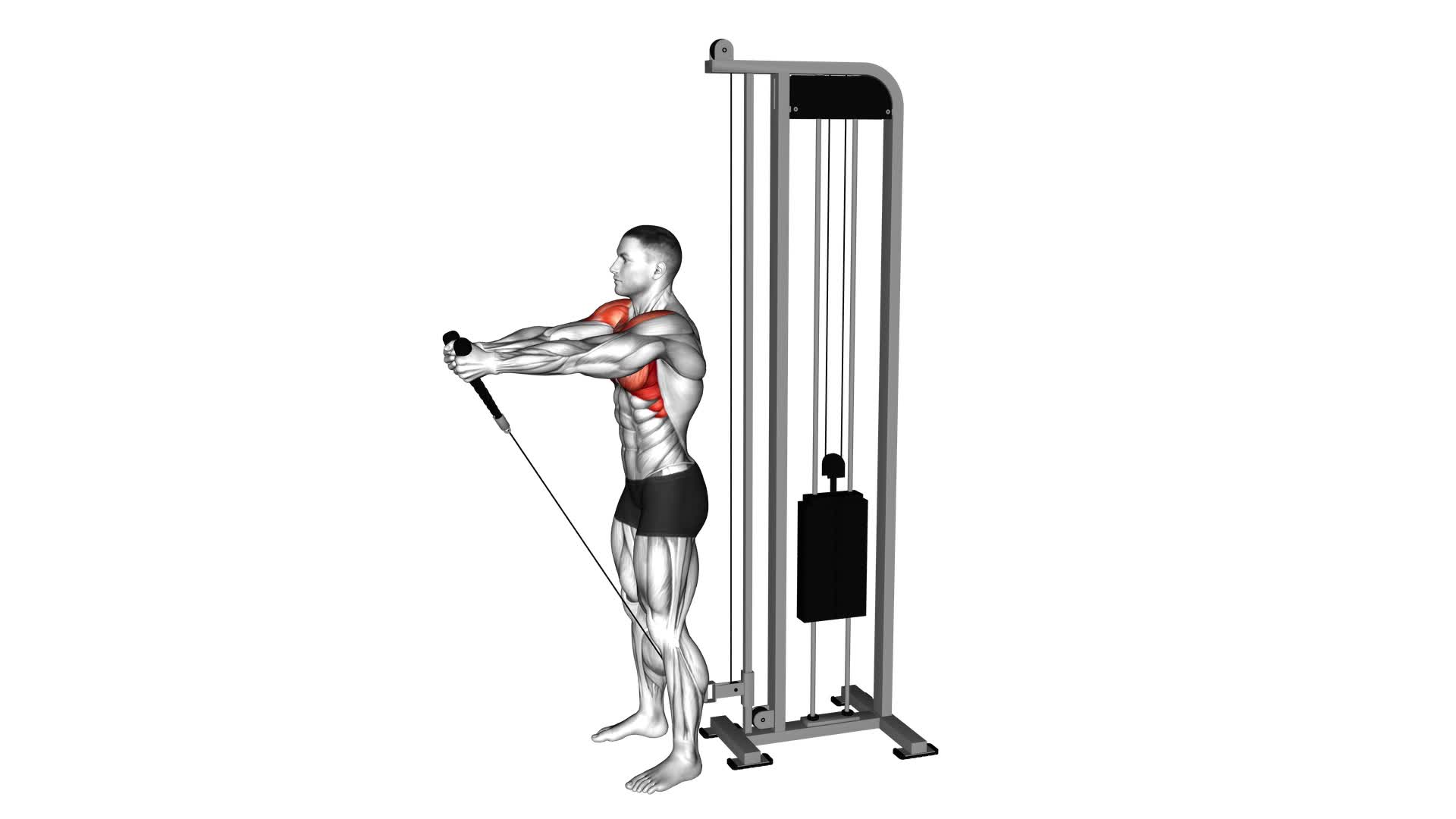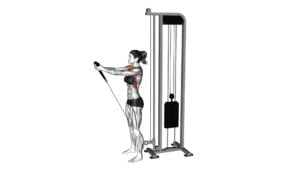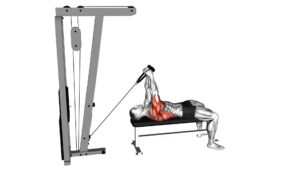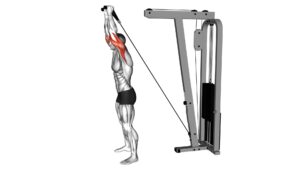Cable Front Raise (Rope Attachment) (Male) – Video Exercise Guide & Tips

Looking to strengthen your shoulders and build upper body strength? Check out this video exercise guide for the Cable Front Raise with Rope Attachment.
Watch This Exercise Video
In just a few minutes, you'll learn proper form and technique, variations and modifications, and tips to maximize your results.
Whether you're a beginner or an experienced lifter, this exercise is a great addition to your routine.
So grab that rope attachment and get ready to elevate your workout.
Let's dive in!
Key Takeaways
- Cable front raise targets multiple muscles including the anterior deltoid, lateral deltoid, and upper pectoralis major.
- Proper form and technique involve maintaining a neutral grip, using slow and controlled motions, and keeping the elbows slightly bent.
- Common errors to avoid include using too much weight, relying on momentum instead of controlled movements, and improper hand placement on the rope attachment.
- Variations and modifications for cable front raise include bent-over cable front raise, single-arm cable front raise, and cable front raise with external rotation.
Benefits of Cable Front Raise With Rope Attachment
You should frequently perform cable front raises with a rope attachment to maximize the benefits of this exercise. This variation of the cable front raise is highly effective for muscle activation and provides a range of equipment options to suit your needs.
When it comes to muscle activation, the cable front raise with a rope attachment targets the anterior deltoid, which is the front part of your shoulder muscles. This exercise also engages the lateral deltoid and the upper pectoralis major. By performing this movement regularly, you can strengthen and tone these muscles, leading to improved shoulder stability and overall upper body strength.
One of the advantages of using a rope attachment for cable front raises is the added grip challenge. The rope allows for a neutral grip, which places less stress on the wrists and forearms compared to using a bar or dumbbells. This can be particularly beneficial if you have any wrist or forearm issues.
Another benefit of the rope attachment is the versatility it offers. You can adjust the grip width to target different areas of the shoulder muscles. A wider grip will emphasize the lateral deltoids, while a narrower grip will focus more on the front deltoids.
Proper Form and Technique for Cable Front Raise
To perform the cable front raise with proper form and technique, focus on maintaining a neutral grip and engaging the targeted shoulder muscles. Start by attaching a rope to the cable machine at a low setting. Stand facing the machine with your feet shoulder-width apart and your knees slightly bent. Grasp the rope with an overhand grip, palms facing down. Keep your back straight and core engaged throughout the exercise.
As you lift the rope, aim to raise it to shoulder height. Avoid using momentum or swinging your body to lift the weight. Instead, use a slow and controlled motion, focusing on the contraction of your shoulder muscles. Keep your elbows slightly bent to prevent strain on your joints.
Common errors to watch out for include using too much weight, which can lead to improper form and reduced effectiveness of the exercise. It's important to choose a weight that allows you to maintain proper form and complete the desired number of repetitions.
If you don't have access to a cable machine, there are alternative exercises that can target the same shoulder muscles. Dumbbell front raises, barbell front raises, or resistance band front raises can all be effective alternatives.
Now that you know the proper form and technique for the cable front raise, let's explore some variations and modifications to add variety to your shoulder workout.
Variations and Modifications for Cable Front Raise
To add variety to your shoulder workout, try incorporating different variations and modifications of the cable front raise exercise.
One alternative is the bent-over cable front raise, which involves bending at the waist and raising the cables in front of you. This variation puts more emphasis on the rear delts and upper back muscles.
Another option is the single-arm cable front raise, where you hold one cable handle and raise it in front of you. This variation helps to improve stability and balance.
If you're looking for advanced cable front raise variations, you can try the cable front raise with external rotation. This involves starting with your arms down by your sides and then externally rotating them as you raise the cables in front of you. This variation targets the rotator cuff muscles and helps to improve shoulder stability.
Another advanced option is the cable front raise with a pause at the top. Instead of raising the cables in one continuous motion, you pause for a second at the top of the movement before lowering them back down. This variation increases time under tension and can lead to greater muscle growth.
Incorporating these cable front raise alternatives and advanced variations into your shoulder workout can help prevent boredom, stimulate new muscle growth, and improve overall shoulder strength and stability. Remember to start with lighter weights and focus on proper form before progressing to more challenging variations.
Common Mistakes to Avoid During Cable Front Raise
Avoid these common mistakes when performing the cable front raise exercise:
- Using too much weight. It's important to choose a weight that allows you to maintain proper form throughout the exercise. Using excessive weight can lead to poor posture and strain on your shoulders and neck.
- Using momentum to lift the weight. Remember to perform the exercise in a slow and controlled manner, focusing on engaging the targeted muscles. Using momentum not only reduces the effectiveness of the exercise but also increases the risk of injury.
- Improper hand placement. Make sure to grip the rope attachment firmly, with your palms facing down. This helps to engage your shoulder muscles more effectively and prevents unnecessary strain on your wrists.
- Shrugging your shoulders or arching your back during the exercise. Keep your shoulders down and back, with a straight posture throughout the movement. This ensures that you target the front deltoids properly and maintain stability.
Tips to Maximize Results With Cable Front Raise
To maximize your results with cable front raise, focus on these key tips. Whether you're a beginner or an experienced lifter, these tips will help you get the most out of this exercise.
For beginners, it's important to start with a lighter weight and focus on proper form. This exercise primarily targets the front deltoids, so make sure to keep your core engaged and your back straight throughout the movement. Avoid using momentum to lift the weight and instead, focus on controlled and smooth movements.
As you progress, you can incorporate advanced training techniques to challenge your muscles even further. One technique is to use a staggered stance, with one foot slightly in front of the other. This will engage more stabilizer muscles and increase the difficulty of the exercise. Another technique is to perform the exercise with one arm at a time, which will further isolate and target the front deltoid.
Remember to always warm up before performing this exercise and listen to your body. If you experience any pain or discomfort, stop immediately and consult a professional.
With consistency and proper technique, cable front raise can be an effective exercise to strengthen and sculpt your shoulders.
Frequently Asked Questions
How Many Reps and Sets Should I Do for Cable Front Raises With a Rope Attachment?
To properly perform cable front raises with a rope attachment, it's important to know how many reps and sets to do.
Without the context of Cable Front Raise (Rope Attachment) (Male) – Video Exercise Guide & Tips {737112}, the answer is as follows.
Aim for 3-4 sets of 8-12 reps, focusing on maintaining proper form and technique throughout.
Start with a weight that challenges you but allows for controlled movements.
Avoid swinging or using momentum, and remember to engage your core for stability.
Can Cable Front Raises With a Rope Attachment Be Done by Beginners?
Yes, beginners can definitely do cable front raises with a rope attachment. This exercise variation is a great way to target your shoulder muscles and improve upper body strength.
Cable exercises offer several benefits, such as providing constant tension throughout the movement and allowing for a wide range of motion. By incorporating cable front raises into your workout routine, you can effectively work your shoulders and gradually increase the weight as you progress.
Are There Any Alternative Exercises That Target the Same Muscles as Cable Front Raises With a Rope Attachment?
If you're looking for alternative exercises that target the same muscles as cable front raises with a rope attachment, there are a few options you can try.
One option is dumbbell front raises, which work the same muscles but without the cable resistance.
Another option is barbell front raises, which can provide a similar movement pattern.
Both of these exercises can help strengthen your anterior deltoids and upper body.
However, cable front raises with a rope attachment offer unique benefits such as constant tension throughout the movement.
Can Cable Front Raises With a Rope Attachment Help Improve Shoulder Stability?
Cable front raises with a rope attachment can be beneficial for improving shoulder stability. By incorporating this exercise into your shoulder workout routine, you can target the muscles responsible for shoulder stabilization.
To perform cable front raises with proper technique and form, grasp the rope attachment, stand with feet shoulder-width apart, and raise your arms in front of you until they're parallel to the floor. Remember to keep your core engaged and avoid using momentum to lift the weight.
Is It Necessary to Use a Rope Attachment for Cable Front Raises, or Can I Use a Different Attachment?
Yes, you have options when it comes to cable front raises. While using a rope attachment can be beneficial for targeting your shoulder muscles, it's not the only option.
You can also use a straight bar or even a handle attachment. The key is to choose an attachment that allows you to maintain proper form and effectively target your shoulders.
Experiment with different attachments to find what works best for you.
Conclusion
In conclusion, the cable front raise with rope attachment is an effective exercise for targeting the front deltoids and improving shoulder strength and stability.
By maintaining proper form and avoiding common mistakes, you can maximize the benefits of this exercise.
Additionally, incorporating variations and modifications can help to challenge your muscles in different ways.
Remember to always listen to your body and adjust the weight and intensity as needed to ensure safety and effectiveness.
Keep up the great work and enjoy the results of your cable front raise workouts!

Author
Years ago, the spark of my life’s passion ignited in my mind the moment I stepped into the local gym for the first time. The inaugural bead of perspiration, the initial endeavor, the very first surge of endorphins, and a sense of pride that washed over me post-workout marked the beginning of my deep-seated interest in strength sports, fitness, and sports nutrition. This very curiosity blossomed rapidly into a profound fascination, propelling me to earn a Master’s degree in Physical Education from the Academy of Physical Education in Krakow, followed by a Sports Manager diploma from the Jagiellonian University. My journey of growth led me to gain more specialized qualifications, such as being a certified personal trainer with a focus on sports dietetics, a lifeguard, and an instructor for wellness and corrective gymnastics. Theoretical knowledge paired seamlessly with practical experience, reinforcing my belief that the transformation of individuals under my guidance was also a reflection of my personal growth. This belief holds true even today. Each day, I strive to push the boundaries and explore new realms. These realms gently elevate me to greater heights. The unique combination of passion for my field and the continuous quest for growth fuels my drive to break new ground.







